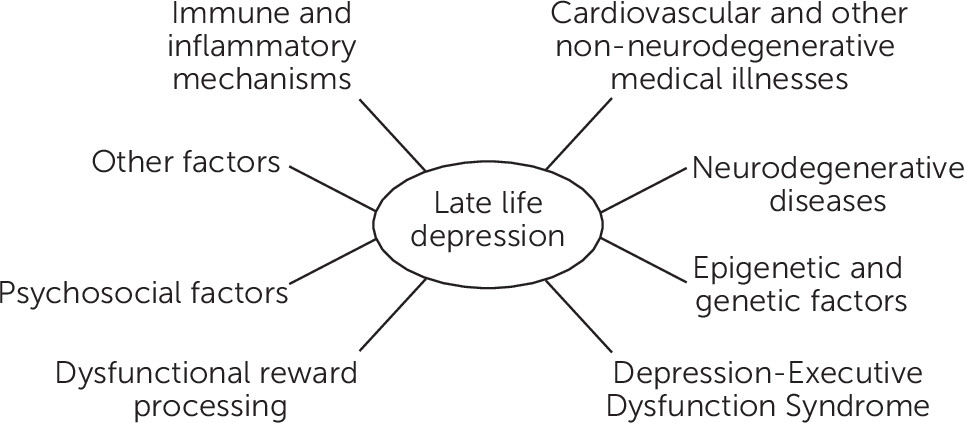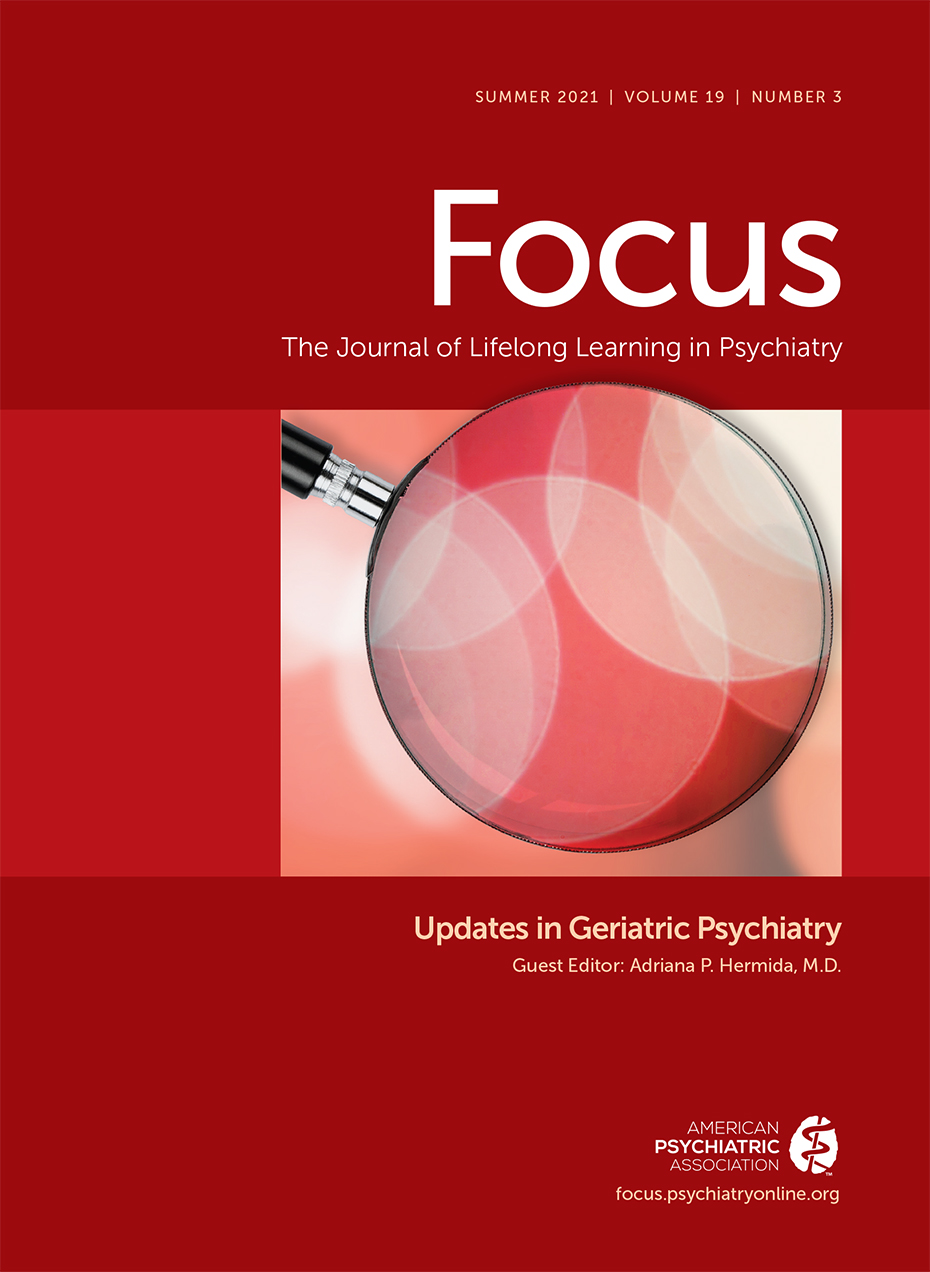Psychotherapy
Evidence-based psychotherapies, alone or with pharmacotherapy, are recommended for older individuals with mild to moderate depression (
70); they are also recommended for individuals with inadequate or adverse response to therapeutic doses of antidepressants or who are at risk for drug interactions secondary to polypharmacy, which is a particularly important concern among older adults. However, cognitive and sensory impairments as well as access issues such as therapist unavailability, impaired patient mobility, and limited transportation options can interfere with this form of treatment. Randomized controlled trials have provided support for the efficacy of several psychotherapeutic approaches, which can be chosen and customized on the basis of individual needs and resources. Cognitive-behavioral therapy (CBT), problem-solving therapy (PST), interpersonal therapy (IPT), and Engage therapy (
87) have been shown effective in treating LLD (
88). Each of these approaches is amenable to delivery within a time frame that is customized for the individual, in briefer sessions if necessary and in a problem-focused manner.
CBT, which is based on the premise that inaccurate beliefs lead to maladaptive thoughts and behaviors, is an established and effective approach to treating LLD. In CBT, the therapist is an interactive coach and teacher, helping a patient to identify and alter dysfunctional cognitions while also encouraging behavioral activation and the scheduling of pleasant events. A recent multicenter study showed CBT, with modifications, to be effective in treating LLD (
89). These modifications concern both the delivery of treatment and the content of sessions (
90). Older adults sometimes find it easier to participate in shorter but more numerous sessions. Engagement with the issues can be enhanced through use of summarization and symptom assessment. Behavioral interventions should target the concerns most relevant to older adults, such as counteracting loneliness through an increase in social engagement.
PST conceptualizes depression as a consequence of a skill deficit. Acting as a sort of project manager and coach, the PST therapist helps a patient with depression to learn and apply new skills or to utilize abilities that were not learned or have fallen into disuse (
91). The PST therapist teaches effective problem-solving techniques by providing a structured approach for defining a goal, planning a strategic solution, and monitoring progress toward success, which can be used in diverse populations (
92). In one studied cohort, PST was significantly more efficacious than supportive therapy in reducing suicidality among older adults with major depressive disorder and significant executive dysfunction (
93). This and other evidence suggest that PST may even have a role in treating older adults with depression and mild degrees of cognitive impairment (
94).
IPT was designed to address depression arising from alterations in one’s interpersonal environment. It focuses on one or two of four areas frequently encountered in LLD: role transitions (significant life change), role disputes (conflict with a partner or another person), death of a loved one (complicated grief), and interpersonal deficits (isolation and loneliness or lack of a purpose) (
95). Individuals with LLD often blame themselves inaccurately, and an IPT therapist can help the individual reframe the reactions to life changes as treatable life disruptions rather than moral failures. Redefining problems in this way reduces self-blame and clarifies the relationship between depressive symptoms and life events. Identifying and processing the precipitating circumstances with IPT can counteract depressive symptoms.
Engage therapy claims to differ from other psychotherapies as a result of its grounding in the principles of the Research Domain Criteria (RDoC) initiative, an effort to integrate multiple levels of evidence (genetics, molecules, cells, circuitry, behavior, physiology, and self-report) to explore basic elements of functioning to better understand and treat mental illness. Engage therapy postulates that depression reflects dysfunction of the positive valence (reward) system, and it uses reward exposure as its principal intervention to depressive symptoms (
96). In RDoC terms, the commonly encountered barriers to treatment response are negativity bias (negative valence system dysfunction), apathy (arousal system), or emotional dysregulation (cognitive control dysfunction). Strategies targeting these dysfunctions are added when needed. For example, methods for addressing negativity bias can include discussing or writing alternative positive explanations to negative thoughts. Strategies for addressing apathy can consist of prompts to initiate action plans or even reminders from others. Emotional dysregulation can be countered by mindfulness activities such as meditation or deep breathing (
96).
An additional promising related nonpharmacologic approach, computerized cognitive remediation, uses computer software designed to provide training in cognitive control and to enhance responsiveness of the reward system (
97). This type of approach is personalized and continuously adapts its level of difficulty on the basis of the individual’s aptitude, both at baseline and through the course of treatment; this approach also provides consistent supportive feedback to avoid frustration or discouragement (
15).
Pharmacotherapy
Despite research demonstrating the importance of psychosocial factors, the treatment of LLD in specialty settings or primary care very often relies upon the use of pharmacotherapy. Studies have shown that among older individuals with moderate to severe depression, antidepressants are more efficacious when compared with placebo (
81). Any of the FDA-indicated antidepressants may be used, with a reported response rate of 50%–65% in randomized controlled trials with intention to treat compared with a 25%–30% response to placebo treatment. The intention to treat remission rate with treatment is lower: 30%–40% versus 15% for placebo (
98). Individual risks and benefits are likely to vary as a result of pharmacokinetic and pharmacodynamic differences that affect the interaction between patient and medication. In cases of treatment resistance, augmentation strategies and coprescribing have successfully been used.
Table 2 lists some of the commonly used antidepressants and augmenters in LLD with typical dosing ranges (
99–
106).
It is not our goal here to offer specific guidance regarding choice of antidepressant, an exhaustive list of antidepressants, or the procedure for dosing and monitoring treatment, all of which have been reviewed extensively elsewhere (
107). General pharmacotherapy principles in LLD include choosing a medication with an eye to potential adverse effects, starting at a low dose, increasing gradually to optimal benefit, and discontinuing after nonresponse or appropriate response and maintenance.
Treatment-resistant depression often requires the use of an augmenter or combination intervention, whereas depression with psychotic features usually requires the combination of an antidepressant with an antipsychotic medication. After remission is achieved, relapse and recurrence rates are diminished by maintenance pharmacotherapy. The focus in successful treatment of LLD must reach beyond treatment of the individual episode and take into account the long-term view, which includes maintenance therapy for prevention of future episodes. In the context of recurrent LLD episodes, extended maintenance pharmacotherapy has been suggested, and limited evidence is available to help the clinician assess the optimal time for antidepressant discontinuation (
108).
As in the adult population, careful management of adverse effects is an essential element of successful pharmacotherapy. Selective serotonin reuptake inhibitors are commonly associated with gastrointestinal side effects, changes in weight, hyponatremia, sexual dysfunction, and bruising; they are much less frequently associated with some more serious adverse effects, including gastrointestinal bleeding and cardiac arrhythmias. Tricyclic antidepressant (TCA) use has been associated with sedation, postural hypotension, and anticholinergic side effects such as blurred vision, constipation, urinary retention, and confusion. Less frequent but more severe events include delirium and cardiac conduction disturbances, including ventricular arrhythmias that account for the lethality of TCA overdose.
Broadly, antidepressant side effects can be anticipated on the basis of the medications’ pharmacokinetic characteristics and the pharmacodynamic properties of the medications listed in
Table 3; practitioners can anticipate and monitor parameters accordingly. In general, our recommendation is that for older individuals with LL D whose symptoms are managed with antidepressants, providers should consider obtaining a baseline electrocardiogram, CBC, and basic metabolic panel before initiating medications. These parameters can be reviewed after dose titration or as clinically indicated.
Neuromodulation
Electroconvulsive therapy (ECT) remains an effective but underused treatment option for LLD (
109,
110). ECT is especially useful among individuals with antidepressant intolerance or nonresponse; it is also beneficial when treating LLD associated with delusions, catatonia, and mania (
87). The acute antidepressant efficacy of ECT has repeatedly been shown superior to other antidepressant treatment modalities, including pharmacotherapy and psychotherapy. Because of its rapid effect, ECT is the treatment of choice for patients who are urgently ill, including those with psychosis and strong suicidal ideation from depression. ECT treatment of LLD can be associated with transient memory disturbance and significant posttreatment relapse rates; however, the procedure is considered relatively safe for older adults and has been demonstrated to be one of the most effective treatment options for LLD (
111). No definitive guideline has identified the optimal number of ECT treatments for patients with LLD. One influential suggestion, from the 2009 Prolonging Remission In Depressed Elderly (PRIDE) study, is to provide at least four additional maintenance ECT treatments following a successful course of ECT, with further treatments as clinically indicated (
112).
Repetitive transcranial magnetic stimulation (rTMS) is an additional neuromodulatory approach that has consistently been reported as safe and well tolerated with minimal cognitive adverse effects and a low dropout rate. Evidence of efficacy of rTMS in treating patients with LLD who have failed antidepressant treatments, including patients with treatment-resistant vascular depression (
113), has generated interest in its use as a first line treatment. Many clinicians and patients see it as an alternative to medications suitable for individuals hesitant to undergo or unable to tolerate ECT. Older individuals require some modifications of rTMS administration, such as adjustment of the treatment schedule and the use individualized treatment protocols. Identification of factors predictive of rTMS response will further improve its therapeutic potential (
114). Deep rTMS is a technical refinement that compensates for age-associated brain atrophy, which increases the distance of the brain from the applied magnetic field. A recent study showed that delivery of deep rTMS using an H1 coil over the dorsolateral and ventrolateral prefrontal cortex achieved a higher remission rate than sham rTMS (40.0% vs. 14.8%) and may be especially suitable for use among patients with treatment-resistant LLD (
115).
Collaborative Care
Given the shortage of geriatric psychiatrists and the prevalence of LLD, researchers have explored methods for improving the recognition and management of LLD in primary care settings. The IMPACT study, which is one of the larger treatment trials for LLD, showed that a collaborative care model can increase the effectiveness of treating LLD in primary care settings. Older adults are more likely to seek depression treatment from a primary care provider than from a mental health specialist; however, treatment as usual in primary care may is less efficacious than collaborative treatment in the primary setting that incorporates guidance from a depression care specialist.
Results from the IMPACT study showed that at 12 months, about half of the primary care patients receiving collaborative care for depression reported at least a 50% reduction in depressive symptoms compared with only 19% of those in usual care. Surveys conducted 1 year after the study showed that the benefits of the IMPACT intervention persisted at follow-up assessment (
116). Other collaborative care models, some of which engage community health workers, have also been successful. These models present an effective and affordable approach that can improve engagement of different racial-ethnic minority groups within the LLD population (
117).


